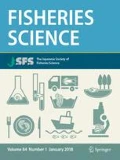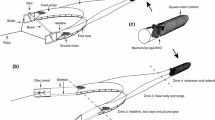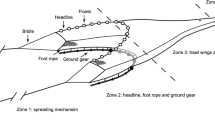Abstract
Three experiments were done to test for the influences of different (i) hanging ratios (E=0.5, 0.65 and 0.8); (ii) fishing heights (25 and 12 meshes); and (iii) twine diameters (0.41, 0.56 and 0.62 mm) and materials (multifilament nylon and multimonofilament nylon polyamide) on catches and by-catches in the estuarine gillnet fishery for Platycephalus fuscus in New South Wales, Australia. In each experiment, the various 100-m treatment panels comprising 80-mm (nominal) mesh rigged according to the different configurations being examined were configured in a single gang between 1090 and 1310 m in length, and fished according to commercial practices. The results showed no significant differences between different hanging ratios or twine diameters for the numbers, weights and size compositions of catches and by-catches. Twine material had an effect on only one key by-catch species (Acanthopagrus australis), with fewer caught in panels made from multifilament nylon compared with multimonofilament nylon. In contrast to the above modifications, lowering the fishing height of the floatline significantly reduced total by-catch by up to 46% and the individuals of key by-catch species (Mugil cephalus, A. australis and Girella tricuspidata) by between 60 and 85% with no effect on catches of targeted P. fuscus, or legally retained byproduct, Portunus pelagicus. The results are used to provide directions for the future management of this fishery and have relevance to other similar bottom-set gillnet fisheries.
Similar content being viewed by others
References
Saila SB. Importance and assessment of discards in commercial fisheries. FAO Fish. Circ. 1983; 765: 62.
Andrew NL, Pepperell JG. The by-catch of shrimp trawl fisheries. Oceanogr. Mar. Biol. Ann. Rev. 1992; 30: 527–565.
Alverson DL, Freeberg MH, Murawski SA, Pope JG. A global assessment of fisheries bycatch and discards, FAO Fish. Tech. Pap. 1994; 339: 233.
Broadhurst MK. Modifications to reduce bycatch in prawn trawls: a review and framework for development. Rev. Fish Biol. Fish 2000; 10: 27–60.
Trippel EA, Strong MB, Terhune JM, Conway JD. Mitigation of harbour porpoise (Phocoena phocoena) by-catch in the gill-net fishery in the lower Bay of Fundy. Can. J. Fish. Aquat. Sci. 1999; 56: 113–123.
Melvin EF, Parrish JK, Conquest LL. Novel tools to reduce seabird bycatch in coastal gillnet fisheries. Conserv. Biol. 1999; 13: 1386–1397.
Cox TM, Read AJ, Swanner D, Urian K, Waples D. Behavioural responses of bottlenose dolphins, Tursiops truncatus. to gillnets and acoustic alarms. Biol. Conserv. 2003; 115: 203–212.
Akiyama S. Discarded catch of set-net fisheries in Tateyama Bay. J. Tokyo. Univ. Fish 1997; 84: 53–64.
Lamberth SJ, Sauer WHH, Mann BQ, Brouwer SL, Clark BM, Erasmus C. The status of the South African beach-seine and gill-net fisheries. S. Afr. J. Mar. Sci. 1997; 18: 195–202.
Gray CA. Management implications of discarding in an estuarine multi-species gill net fishery. Fish. Res. 2002; 56: 177–192.
Gray CA, Johnson DD, Young DJ, Broadhurst MK. Discards from the commercial gillnet fishery for dusky flathead, Platycephalus fuscus, in New South Wales, Australia: spatial variability and initial effects of change in minimum legal length of target species. Fish. Manag. Ecol. 2004; 4: 1–12.
Gray CA, Johnson DD, Broadhurst MK, Young DJ. Seasonal, spatial and gear-related influences on relationships between retained and discarded catches in a multi-species gillnet fishery. Fish. Res. 2005; 75: 56–72.
Hutchings K, Lamberth SJ. Bycatch in the gillnet and beachseine fisheries in the Western Cape, South Africa, with implications for management. S. Afr. J. Mar. Sci. 2002; 24: 227–241.
Purbayanto A, Tsunoda A, Akiyama S, Arimoto T, Tokai T. Survival of Japanese whiting and by-catch species captured by sweeping trammel-net. Fish. Sci. 2001; 67: 21–29.
Berrow SD. Incidental capture of elasmobranchs in the bottom-set gill-net fishery off the south coast of Ireland. J. Mar. Biol. Assoc. U.K. 1994; 74: 837–847.
Madsen N, Holst R, Wileman D, Moth-Poulson T. Size selectivity of sole gill nets fished in the North Sea. Fish. Res. 1999; 44: 59–73.
Trent L, Parshley DE, Carlson JK. Catch and bycatch in the shark drift gillnet fishery off Georgia and East Florida. Mar. Fish. Rev. 1997; 59: 19–28.
Hickford MJH, Schiel DR, Jones JB. Catch characteristics of commercial gill-nets in a nearshore fishery in central New Zealand. NZ J. Mar. Freshw. Res. 1997; 31: 249–259.
Stergiou KI, Moutopoulos DK, Erzini K. Cill net and longline fisheries in Cyclades waters (Aegean Sea). Species composition and gear competition. Fish. Res. 2002; 57: 25–37.
Santos MND, Gaspar M, Monteiro CC, Erinzi K. Gill net selectivity for European hake Merluccius merluccius from southern Portugal: implications for fishery management. Fish. Sci. 2003; 69: 873–882.
Park C, Jeong E, Shin J, An H, Fujimori Y. Mesh selectivity of encircling gill net for gizzard shad Konosirus punctatus in the coastal sea of Korea. Fish. Sci. 2004; 70: 553–563.
Hamley JM. Review of gillnet selectivity. J. Fish. Res. Bd. Can. 1975; 32: 1943–1969.
Marais JFK. Some factors influencing the size of fishes caught in gillnets in eastern cape estuaries. Fish. Res. 1985; 3: 251–261.
McCombie AM, Berst AH. Some effect of shape and structure of fish on selectivity of gillnets. J. Fish. Res. Bd. Can. 1969; 26: 2681–2689.
Reis EG, Pawson MG. Fish morphology and estimating selectivity by gillnets. Fish. Res. 1999; 39: 263–273.
Hovgård H, Lassen H. Manual on estimation of selectivity for gill net and long line gears in abundance surveys. FAO Fish. Tech. Pap. 2000; 397: 1–84.
Dickson W. Cod gillnet simulation mode. Fish. Res. 1989; 7: 149–174.
Purbayanto A, Akiyama S, Tokai T, Arimoto T. Mesh selectivity of a sweeping trammel net for Japanese whiting. Fish. Sci. 2000; 66: 97–103.
Yokota K, Fujimori Y, Shiode D, Tokai T. Effect of thin twine on gill net size-selectivity analyzed with the direct estimation method. Fish. Sci. 2001; 67: 851–856.
Machiels MAM, Klinge M, Lanters R, van Densen WLT. Effect of snood length and hanging ratio on efficiency and selectivity of bottom-set gillnets for pikeperch, Stizostedion lucioperca L & bream, Abramis brama. Fish. Res. 1994; 29: 231–239.
Samaranayaka A, Engas A, Jorgensen T. Effects of hanging ratio and fishing depth on the catch rates of drifting tuna gillnets in Sri Lankan waters. Fish. Res. 1997; 29: 1–12.
Millar RB, Fryer RJ. Estimating the size-selection curves of towed gears, traps, nets and hooks. Rev Fish Biol. Fish 1999; 9: 89–116.
Holst R, Wileman D, Madsen N. The effects of twine thickness on the size selectivity and fishing power of Baltic cod gill nets. Fish. Res. 2002; 56: 303–312.
Godoy H, Furevik D, Lokkeborg S. Reduced bycatch of red king crab (Paralithodes camtschaticus) in the gillnet fishery for cod (Gadus morhua) in northern Norway. Fish. Res. 2003; 62: 377–384.
Gray CA, Gale VJ, Stringfellow SL, Raines LP. Variations in sex, length and age compositions of commercial catches of Platycephalus fuscus (Pisces: Platycephalidae) in New South Wales. Australia. Mar. Freshwat. Res. 2002; 53: 1091–1100.
Broadhurst MK, Gray CA, Young DJ, Johnson DD. Relative efficiency and size selectivity of bottom-set gillnets for dusky flathead, Platycephalus fuscus and other species in New South Wales, Australia. Arch. Fish. Mar. Res. 2003; 50: 289–302.
Sainsbury JC. Commercial Fishing Methods. an Introduction to Vessels and Gears, 3rd edn. Fishing News Books, Oxford. 1996.
Underwood AJ. Techniques of analyses of variance in experimental marine biology and ecology. Ocean. Mar. Biol. Ann. Rev. 1981; 19: 513–605.
Acosta AR. Soak time and net length effects on catch rates of entangling nets in coral reef areas. Fish. Res. 1994; 19: 105–119.
Acosta AR, Appledoorn RS. Catching efficiency and selectivity of gillnets and trammel nets in coral reefs from southwestern Puerto Rico. Fish. Res. 1995; 22: 175–196.
Jensen JW. A direct estimate of gillnet selectivity for brown trout. J. Fish. Biol. 1995; 46: 857–861.
Henderson BA, Nepszy SJ. Comparison of catches in monoand multifilament gill nets in Lake Erie. N. Am. J. Fish. Manag. 1992; 12: 618–624.
Hovgård H. Effect of twine diameter on fishing power of experimental gill nets used in Greenland waters. Can. J. Fish. Aquat. Sci. 1996; 53: 1014–1017.
Chopin FS, Arimoto T. The condition of fish escaping from fishing gears—a review. Fish. Res. 1995; 21: 315–327.
Author information
Authors and Affiliations
Corresponding author
Rights and permissions
About this article
Cite this article
Gray, C.A., Broadhurst, M.K., Johnson, D.D. et al. Influences of hanging ratio, fishing height, twine diameter and material of bottom-set gillnets on catches of dusky flathead Platycephalus fuscus and non-target species in New South Wales, Australia. Fish Sci 71, 1217–1228 (2005). https://doi.org/10.1111/j.1444-2906.2005.01086.x
Received:
Accepted:
Issue Date:
DOI: https://doi.org/10.1111/j.1444-2906.2005.01086.x




